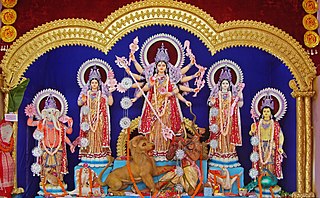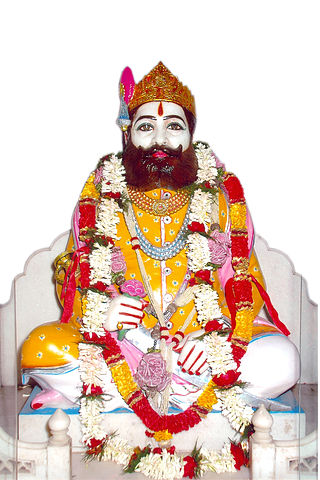Religion in Jharkhand [1]
Hinduism is the majority religion in Jharkhand, followed by nearly 67.83% of total population as of 2011 census. There has also been a significant population of followers of Islam and Sarnaism, with 14.53% and 12.52% respectively[ citation needed ] and Christianity being a significant minority, followed by 4.3%. A small numbers of Sikhs and other religion are also present. [1]
Jharkhand is a diverse state of India and has a diverse religious population, where the majority of the population follow Hinduism, with Islam as the second most followed religion. [2] The state has also a very high proportion of tribal population, where the majority religion is Sarnaism. [3] In recent times, due to missionary activities, there has been a significant rise of Christianity in Jharkhand which is more than the national average population of Christians in India. [4] A small community of Agrahari Sikh and Jains. [5]
| Population by religion (%) | |||
|---|---|---|---|
| S. No. | Religion | 2001 [6] | 2011 [1] |
| 1. | Hinduism | 68.50 | 67.83 |
| 2. | Islam | 13.80 | 14.53 |
| 3. | Sarnaism | 13.04 | 12.52 |
| 4. | Christianity | 4.05 | 4.31 |
| 5. | Sikhism | 0.31 | 0.22 |
| 6. | Others | 0.8 | 0.41 |
| 7. | Not stated | n/a | 0.19 |

The North-West Frontier Province was a province of British India from 1901 to 1947, of the Dominion of Pakistan from 1947 to 1955, and of the Islamic Republic of Pakistan from 1970 to 2010. It was established on 9 November 1901 from the north-western districts of the British Punjab, during the British Raj. Following the referendum in 1947 to join either Pakistan or India, the province voted hugely in favour of joining Pakistan and it acceded accordingly on 14th August, 1947. It was dissolved to form a unified province of West Pakistan in 1955 upon promulgation of One Unit Scheme and was re-established in 1970. It was known by this name until 19 April 2010, when it was dissolved and redesignated as the province of Khyber Pakhtunkhwa following the passing of the Eighteenth Amendment to the Constitution of Pakistan, by erstwhile President Asif Ali Zardari.
The tribes of Jharkhand consist of 32 scheduled tribes inhabiting the Jharkhand state in India. In 1872, only 18 tribes were counted among the schedule tribes from which Banjara, Bhatudi, Chik Baraik and Mahli were marked as semi-Hindu aboriginal and Kora as proletariat Hindu. In the 1931 census, including the above four semi-Hindu aboriginal and Kora, a proletariat Hindu, the number was raised to 26 from 18 by adding four more in the annexure. They were Birajia, Godait, Karmali and Paharia, but Kisan was excluded from the list. In 1941 census, Baga, Bedia and Lohra included again taking Kisan in the annexure and number came to 30 which prevailed till June 2003. Kanwar and Kol were added on 8 June 2003 in the annexure and the number of Schedule Tribes came to 32.
Chuhra, also known as Bhanghi and Balmiki, is a Dalit caste in India and Pakistan. Populated regions include the Punjab region of India and Pakistan, as well as Uttar Pradesh in India, among other parts of the Indian subcontinent such as southern India. Their traditional occupation is sweeping, a "polluting" occupation that caused them to be considered untouchables in the caste system.

The official religion of Pakistan is Islam, as enshrined by Article 2 of the Constitution, and is practised by approximately 96.47% of the country's population. The remaining 3.53% practice Hinduism, Christianity, Ahmadiyya Islam, Sikhism and other religions.
Asia is the largest and most populous continent and the birthplace of many religions including Buddhism, Christianity, Confucianism, Hinduism, Islam, Jainism, Judaism, Shinto, Sikhism, Taoism and Zoroastrianism. All major religious traditions are practiced in the region and new forms are constantly emerging. Asia is noted for its diversity of culture.
Growth of religion involves the spread of individual religions and the increase in the numbers of religious adherents around the world. In sociology, desecularization is the proliferation or growth of religion, most commonly after a period of previous secularization. Statistics commonly measure the absolute number of adherents, the percentage of the absolute growth per-year, and the growth of converts in the world.

Indian Sikhs number approximately 21 million people and account for 1.7% of India's population as of 2011, forming the country's fourth-largest religious group. The majority of the nation's Sikhs live in the northern state of Punjab, which is the only Sikh-majority administrative division in the world.

Religion in India is characterised by a diversity of religious beliefs and practices. Throughout India's history, religion has been an important part of the country's culture and the Indian subcontinent is the birthplace of four of the world's major religions, namely, Hinduism, Buddhism, Jainism, and Sikhism, which are collectively known as native Indian Religions or Dharmic Religions and collectively represent around 83% of the total population of India.
The United Nations categorizes Bangladesh as a moderate democratic Muslim country. Sunni Islam is the largest and most dominant religion practiced in the country. In the Constitution of Bangladesh, Islam is referred to twice in the introduction and Part I of the constitution. The document begins with the Islamic phrase Bismillahir Rahmanir Raheem which in English is translated as "In the name of Allah, the Beneficent, the Merciful" and article (2A) declares that:"Islam is the state religion of the republic".
The Sikhs are adherents to Sikhism, the fifth largest organized religion in the world, with around 25 million adherents. Sikh History is around 500 years and in that time the Sikhs have developed unique expressions of art and culture which are influenced by their faith and synthesize traditions from many other cultures depending on the locality of the adherents of the religion. Sikhism is the only religion that originated in the Punjab region with all other religions coming from outside Punjab. All the Sikh gurus, many saints, and many of the martyrs in Sikh history were from Punjab and from the Punjabi people. Punjabi culture and Sikhism are mistakenly considered inseparably intertwined. "Sikh" properly refers to adherents of Sikhism as a religion, strictly not an ethnic group. However, because Sikhism has seldom sought converts, most Sikhs share strong ethno-religious ties, therefore it is a common stereotype that all Sikhs share the same ethnicity. Many countries, such as the U.K., therefore misconcievingly recognize Sikh as a designated ethnicity on their censuses. The American non-profit organization United Sikhs has fought to have Sikhs included on the U.S. census as well, arguing that Sikhs "self-identify as an 'ethnic minority'" and believe "that they are more than just a religion".

Agrahari, Agraharee or Agarhari is an Indian and Nepali Vaishya community, They are the descendants of legendary king Agrasena. Predominantly, they are found in the Indian state of Uttar Pradesh, Madhya Pradesh, Jharkhand, Chhattisgarh and Terai region of Nepal.

Roughly 8.6 per cent of India's population is made up of "Scheduled Tribes" (STs), traditional tribal communities. Whilst most members of these tribes have adopted variants of Hinduism, Islam, or Christianity, a considerable number still adhere to their traditional tribal religions, with varying degrees of syncretism.
Myanmar (Burma) is a Buddhist majority country with a significant minority of Christians and other groups residing in the country.
Hinduism is the most followed religion in Bihar, followed by nearly 82.7% of total population as per 2011 Census. Islam is the second-most followed religion which is followed by nearly 16.8% of population. There is also a significant population of Jains and Christians in the state.
Punjab is home to 2.3% of India's population; with a density of 551 persons per km2. According to the provisional results of the 2011 national census, Punjab has a population of 27,743,338, making it the 16th most populated state in India. Of which male and female are 14,639,465 and 13,103,873 respectively. 32% of Punjab's population consists of Dalits. In the state, the rate of population growth is 13.9% (2011), lower than national average. Out of total population, 37.5% people live in urban regions. The total figure of population living in urban areas is 10,399,146 of which 5,545,989 are males and while remaining 4,853,157 are females. The urban population in the last 10 years has increased by 37.5%. According to the 2011 Census of India, Punjab, India has a population of around 27.7 million.

Taluka Haveli is a subdivision of the district of Pune, Maharashtra. The Pune Municipal Corporation & Pimpri Chinchwad Municipal Corporation, Pune are at the center of & entirely surrounded by the taluka for administrative purposes. The region of Pune Metropolitan Region has claimed the major part of the same.

Sarnaism is a religious faith of the Indian subcontinent, predominantly followed by indigenous communities in the Chota Nagpur Plateau region across states like Jharkhand, Odisha, West Bengal, Bihar, and Chhattisgarh. This belief centers around the reverence of Sarna, the sacred groves of village communities where the village deity, known as Gram deoti resides, and where sacrificial offerings are made twice a year. It is also referred to as "Sarna Dharma" or the "Religion of the Holy Woods", and it holds the distinction of being India's largest tribal religion.
Religions in Karachi include Islam, Christianity, Hinduism, Sikhism, Buddhism, Zoroastrianism and others. According to a 1998 census of Pakistan, the religious breakdown of the city is as follows: Muslim (96.45%), Christian (2.42%), Hindu (0.86%), Ahmadis (0.17%) and other (0.10%). Other religious groups include Parsis, Sikhs, Baháʼí, Jews and Buddhists. Of the Muslims, approximately 66% are Sunnis and 34% are Shi'ites. The Sunnis follow Hanafi fiqh while Shi'ites are predominantly Ithnā‘Ashariyyah fiqh, with significant minority groups who follow Ismaili Fiqh, which is composed of Nizari, Mustaali, Dawoodi Bohra and Sulaymani fiqhs.
Ghar Wapsi is the programme of religious conversion to Hinduism from Islam, Christianity, and other religions in India conducted by Indian Hindu nationalist organisations Vishva Hindu Parishad (VHP), Rashtriya Swayamsevak Sangh (RSS) and their allies. The term owes to the Hindu nationalist ideology that all people of India are ancestrally Hindu and, hence, conversion to Hinduism is one of "returning home" to their ancestral roots.
The population of Assam consist of tribal ethnic groups, and linguistic groups such as Assamese, Bengali, Hindi speakers and Nepali.